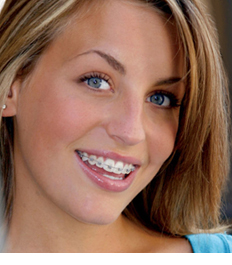You may not have heard the term “malocclusion,” but chances are you know what one looks like! A malocclusion is an improper bite and includes conditions such as crowded or crooked teeth, overbite, and underbite.
A “bad bite” may not only make a person feel self-conscious about their smile—it can also lead to health problems. Crowded and crooked teeth can be more difficult to brush and keep clean, which can lead to tooth decay, gum disease and possibly tooth loss. In the case of an overbite or underbite, even if the teeth appear straight, the upper and lower jaws do not meet properly. This can interfere with chewing and speaking, can cause abnormal wear to tooth enamel, and can put excessive stress on the supporting bone and gum tissue. Sometimes a misalignment of the jaw joints causes chronic headaches or pains in the face and neck.
Usually, a malocclusion is due primarily to genetics—inherited traits. Inherited problems may include overcrowding of teeth, too much space between teeth, cleft palate, and/or a wide variety of other issues involving the structure of the face and jaws. But sometimes environmental factors can be an influence or even the chief cause: dental disease, an injury to the mouth or jaw, premature loss of primary or adult teeth, mouth breathing (an airway restricted by tonsils or adenoids) or a habit such as prolonged thumb-sucking. Many of these factors (genetic and environmental) can affect the entire face as well as the teeth.
Few people, in fact, have a perfect bite. Fortunately for the rest of us, there is orthodontia!
Orthodontia, orthodontics, or orthodonture (from the Greek orthos, “straight or proper,” and odous “tooth”) is the specialty of dentistry that studies and treats malocclusions. Orthodontic care includes the use of braces and other appliances to straighten and align teeth properly, and correct problems with bite.
Most dentists can tell as early as age six or seven—when permanent teeth begin to grow in—if a child will need orthodontic intervention. In young children, orthodontic treatment is sometimes used to guide proper jaw growth. This early action is called interceptive treatment therapy, and involves the wearing of appliances to influence facial growth and help permanent teeth grow in properly.
But most often, treatment begins once all permanent teeth have grown in, usually around ages 10-13. Thus braces have become almost a rite of passage and an expected part of puberty for many adolescents.
Braces have come a long way from the ancient Greeks, who used base metals and cat gut! Now patients can choose from tiny metal brackets, ceramic (tooth-colored) or clear braces, and sometimes even “invisible braces,” which are affixed to the inside surfaces of the teeth.
Braces straighten teeth by exerting steady pressure. The pressure is created by wires, springs, and/or bands attached to the brackets. The tension is adjusted periodically by the orthodontist, and slowly and steadily the teeth and jaw move into their desired positions. Occasionally braces alone are not enough to straighten the teeth or move the jaw, and external forces such as a headgear may also be needed. Treatment usually takes from about six months to three years.
Most people receive orthodontic care as children or adolescents, but many adults get braces, too. The biological process involved in moving teeth is the same at any age, but because the bones of a growing child are more malleable, adult treatment usually takes a little longer than a child’s treatment.
Oral hygiene is always important, but it is even more so when one is wearing braces. Special care must be taken to ensure that food and plaque is cleaned away from the teeth, brackets, wires, etc. If plaque is allowed to build up, permanent stains may develop on the teeth around and under the braces, as well as tooth decay and gum disease.
In addition to proper oral hygiene, taking good care of braces includes avoiding hard, brittle, crunchy and sticky foods, and stopping habits such as chewing pencils and biting fingernails.
Once the braces have finally been taken off, the teeth—although straight and beautiful—are not completely stable in their new positions. The use of a retainer is usually required full-time for about six months, then at night for a period of time ranging from a few months to several years. Whatever the timeframe, a retainer is very important; without it, the teeth could shift back into their old, crooked positions.
Braces are a significant investment of money, time, and effort, but the benefits of an attractive, healthy smile are worth it!


